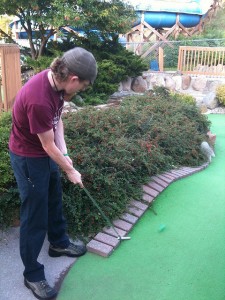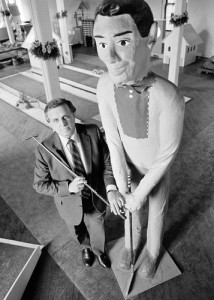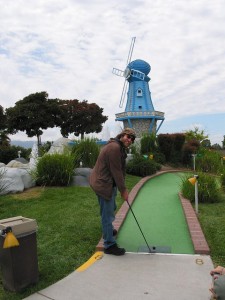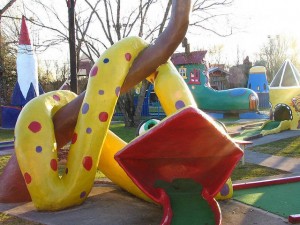In the novel by Miguel de Cervantes, Don Quixote takes his lance and “tilts at windmills” as the saying goes, imagining their blades to be a giant’s arms.
I can relate. I, too, have tilted at windmills — and usually lost . . . on the putting green.
Not one of those manicured, meticulously shaved creations trod by real golfers in their lemon-yellow slacks and white spikes. Naw. Ones made of plain old green carpeting, glued to beds of solid concrete.

Sinking a long miniature-golf putt is more guesswork and luck than skill for most of us. (Ben B Miller, Flickr Creative Commons)
I’m a miniature golfer, you see. My game is the kinda, sorta putting part of golf — with a huge twist. In my kind of golf, windmill hazards and polyethylene gorillas stand astride your sightline, and narrow chutes and bridges drop your ball down to levels where it rolls in a hundred different directions.
My ball, and the club I strike it with, look nothing like the ones that Vijay Singh or Tiger Woods or K.J. Choi’s caddie pulls out of a bag. Mini-golf balls are colored — usually red, yellow, green, and blue — invariably faded and chipped from overuse. Our putters are all the same institutional design, save for their length, and they, too, have been gripped by hundreds or even thousands of others before we get our hands on them.
No caddie hands them to us, that’s for sure. The putter’s our only club, and we lug it around all 18 holes ourselves. Any mini-golfer who brings a real putter to the course is called a pretentious poof, or worse, behind his back.
I am moved to write all this because the sport — activity? — of miniature golf lost a legend a week or so ago. Ralph J. Lomma died at age 87 in Scranton, Pennsylvania.

Ralph Lomma's the one on the left! His zany twists to the staid game of miniature golf revolutionized the business. (Peter Morgan/AP)
It was he who turned what had been the tedious game of miniature golf into an adventure. An early sort of theme park, sprinkled with absurd monsters and mermaids and monoliths.
Mini-golf is thought to have begun in the mid-1800s in a fitting place: St. Andrews in Scotland, which real golfers refer to as the Royal & Ancient Golf Club. Its members decided that their pestering wives and lady friends needed a dignified version of their game to keep them busy while the men whacked golf balls around the gorse. It was thought unseemly for a woman to perform the violent swings that advance a ball down a fairway, but the gentle putting stroke would be acceptable, achievable, and amusing.
So the club created an 18-hole course of just putting greens. They called it “the Himalayas” — odd, since greens are as flat as a flounder. Over the years, other golfing clubs and fancy hotels followed suit, building putting courses on a miniature scale. “Garden golf,” “pitch and putt,” or “par 3 golf,” they called the game that was played there.
Par, for the uninitiated, is the number of swings, or strokes, deemed right and proper to get the ball from the tee into the recessed cup on each of the course’s 18 holes. Making par should be difficult, but not daunting, to achieve.
In the case of miniature golf, that number is often made uniform the whole way through: 4, 3, or even 2 putts per hole. That’s the optimum, and only sometimes the number of strokes YOU will take to put the ball in the cup down the carpeted way.
The first known U.S. mini-course opened in 1916 in Pinehurst, North Carolina. It had a clever name: Thistle Dhu. Or phonetically, “This’ll Do.” A veritable boom in such courses followed.
Each had undulations, twists to the right or left, and idiosyncrasies. A couple of pink, plastic flamingos stuck in the ground next to the holes, perhaps. Various kinds of fake-grass surfaces, too.
Other than that, the mini game was pretty much the same: mildly interesting and challenging over the first few holes, a tad tiresome toward the end.
In 1954, Don Clayton of Fayetteville, North Carolina, created a miniature-golf layout that he called the “Putt-Putt” course, which he charged customers 25 cents to play. It had a few refinements. Each hole was a quick-playing par 2. Sinking one’s ball into each distant hole was doable if you tapped a firm and true putt and didn’t hit a stone or a cigarette butt that someone before you had dropped. Superior play could earn a player a modest prize, typically a free game.

Putt-Putt's not Coke in its reach . . . yet. But you'll find these signs in unlikely places around the world. (me and the sysop, Flickr Creative Commons)
Putt-Putt was rapidly franchised across America and much of the rest of the world. Like dining at McDonald’s, you got pretty much the same experience playing it in New York or New Delhi or New Zealand. The course was entirely predictable.
Ralph Lomma, who had been making and selling skillets and die-cast Christmas ornaments in Scranton, changed all that. In 1955, he and his brother, Alphonse, opened a mini-golf course there that was loaded with wacky obstacles. They included a revolving windmill whose paddles quite likely and infuriatingly would swoop downward and strike your ball just as it arrived, knocking it far from the hole.
Other Lomma courses added spooky castles, zig-zag misdirections, cement alligators whose gaping jaws stood between you and a beautiful shot. Sometimes a plastic whale would spit your ball back at you if you missed the narrow opening inside its mouth. Or a guillotine whose (quite dull) blade dropped, once again, right in front of a perfectly aimed putt.
Lomma’s creations weren’t just thematic decorations. They added elements of skill, a bit of trickery, and a chuckle or two to what had been miniature golf’s monotonous parade of putts. To win at his game, you had to concentrate, not just whack the ball against the course’s wooden bumpers and hope for the best.
Ralph Lomma would create about 6,000 courses around the world, on cruise ships, at federal penitentiaries, and even, he claimed, on an aircraft carrier. That one’s hard to picture.
Mini-golf courses are recession-proof “money machines,” he crowed. For $20,000, a franchisee got a prefabricated course, an array of putters, a good supply of scorecards and pencils, and one embellishment: a happy clown face that collected, and kept, your ball after your last putt — whether you had successfully knocked it in the cup or not.
An all-weather mini-course, once created, would last a quarter of a century with minimal upkeep: maybe a roll of green carpeting now and then, some touch-up paint, perhaps an updated obstacle — a “Star Wars”-type figure instead of a yodeling Tarzan.

Mini-golf is a game for young and old. Even infants can tag along. (mallix, Flickr Creative Commons)
It made for a good, cheap date. Admission almost always cost less than a movie. And as Ralph Lomma himself once said, “With golf, 4-year-olds are too young to swing a club, and 94-year-olds are too old to walk all 18 holes. Mini-golf lets a child and his 94-year-old grandpa play together.”
Others took Lomma’s idea and went wild with it, creating ever-more-imaginative obstacles. “Monster Mini Golf,” for instance, offers INDOOR, 18-hole, glow-in-the-dark courses ringed by fearsome, animatronic creatures.
Mini-golf outings don’t lend themselves to the glory stories one brings home from full golf courses. There’s no “rough” or sand trap out of which to whack an unbelievable shot, no 300-meter fairway lined with ancient oaks, no “signature hole” such as Augusta National’s “Amen Corner” in Georgia, and certainly no grand clubhouse with a lavish dressing room and paneled bar waiting at the end of a round.
Most miniature-golf courses offer only the dumpy shack where you pay your admission, pick out your putter, and bring it back again.

This is not a clever course obstacle. It's an actual grave of what, we can only presume, was a serious mini-golf enthusiast. (Dawn Endico, Flickr Creative Commons)
Mini-golf tales usually center on the embarrassment suffered by strutting males who introduce the game to a girlfriend, spouse, or child — down to and including elaborate instruction about grips, proper footwork, and strategy — only to see them lose, sometimes badly, to their neophyte companion.
“Some of my male friends — great basketball/baseball/football players — lost their cool when it came to the ‘easy’ game of miniature golf,” Washington public-relations expert Charlie Brotman told me. “How could I miss that easy putt?” they mutter, over and over again.
One friend of a friend found a mini-golf course in a tiny town, with “Moose” as part of its name, on James Bay in Northern Ontario. He wondered how the proprietor made of a go of it in a place that’s covered by snow much of the year.

And this is not a mini-golf course. It's a creative MODEL of one. (SeeMidTN.com (aka Brent), Flickr Creative Commons)
At least the colored golf balls are helpful there, he reasoned.
All of us mini-golfers have a favorite color, certain that it brings good luck. I pout when my companion picks green before I can.
It’s fun — some make a production out of it — trying to gauge the angle of a ball’s roll to a hole after it bounces off the side bumper. But it’s no fun at all missing the putt and watching your ball strike the bumper and roll back down the green to you or over a swell to a desolate corner.
Make no mistake. Mini-golf isn’t golf.
• The former is surely no “good walk spoiled,” as Mark Twain called golf. It’s no walk at all to speak of. You stroll down one short green and then another and then 16 more, sometimes just standing around, waiting for others ahead to finish.
• Golf course designers blend their layouts into the natural surroundings, incorporating streams and hillocks and magnificent trees into the field of play. Mini-golf courses are often stuck in a corner of a noisy mall parking lot. Their 18 holes are packed tightly, side by side, so that you’re likely to find yourself addressing a putt on one while someone else is mulling hers right next to you on another.
• Mini-golf courses come to life at night, illuminated by garish floodlights. Idyllic, they are not.
• Nobody obsesses over mini-golf. Or agonizes for more than a moment over a missed putt, invests in lessons and ever-more-expensive equipment, or returns to a course time after time, determined to master it.
• There’s certainly no accepted and expected mini-golf attire. I’ve seen players dressed in tuxedos and bridal gowns — the game’s a cheap honeymoon, too — shorts and flip-flop sandals, T-shirts that don’t quite cover grotesquely protruding bellies, and even, once, a full leprechaun outfit.
• Sometimes, where it’s allowed, players munch on pizza, swig a beer, or puff a cigarette as they play. You don’t see that at St. Andrews.
Miniature-golf courses don’t cost a quarter any more, and their entertainment niche has been largely overtaken by extravagant theme-park rides. Many of the courses I’ve seen lately could use a good scrub and a less-scruffy attendant. So mini-golf may no longer be a “money machine.”
That, of course, is no longer of concern to Ralph Lomma.
Ted's Wild Words
These are a few words from this posting that you may not know. Each time, I'll tell you a little about them and also place them into a cumulative archive of "Ted's Wild Words" in the right-hand column of the home page. Just click on it there, and if there's another word that you'd like me to explain, just ask!
Animatronic. Featuring animation by robotic creatures to mimic the movement of animals.
Gorse. A short, spiny, evergreen shrub common to Western Europe, especially Ireland and rural England. The word also refers to entire golf courses laden with these shrubs.
Leprechaun. A tiny, mischievous sprite in Irish folklore, often depicted by not-so-tiny men in kelly-green costumes.
Undulations. Rising and then falling waves.





2 responses to “Tilting at (Golf) Windmills”
As usual the Lommas are given the credit for their contributions to miniature golf credit that should be given to Robert and Joe Taylor. Robert and Joe Taylor of Binghamton NY started in the miniature golf industry in 1938 17 years before the Lommas. The Taylors and the Lommas knew each other and their philosophies of miniature golf differed so much nether could stand the other. Most of the traditional obstacles people remember from miniature golf were developed and popularized by the Taylors. They built and supplied most of the industry through the seventies from their shop in Appalachian NY. Eastern Golf, Wittek and Harris Golf just to name a few used or carried their obstacles. To the best of my knowledge there isn’t one innovation that the Lommas claim that the Taylors didn’t already have. I worked for them on their courses and in the wood shop and eventually bought one of their courses that was built in 1959 to replace the course that was torn down for the local high school , that course was built in 1947 and it had” Alphonse Lommas clown hole” at the end. In 1961 Bob Taylor, Don Clayton of Putt-Putt, and Frank Abramoff of Arnold Palmer Miniature Golf organized the first miniature golf association known as NAPCOMS (or the “National Association of Putting Course Operators, Manufacturers, and Suppliers”). Their first meeting was held in New York City. Though this organization only lasted a few years it was the first attempt to bring miniature golf operators together to promote miniature golf. The Lommas were invited but didn’t like the idea of an association maybe because compared to the other guys their courses weren’t up to par.
Dear tness,
Thanks for a meaty and helpful perspective on the history of mini-golf. I can only say that I wish I had known about the Taylors’ contribution. I would have given them their due had I. This will help set the record straight. Thanks for it.
Ted